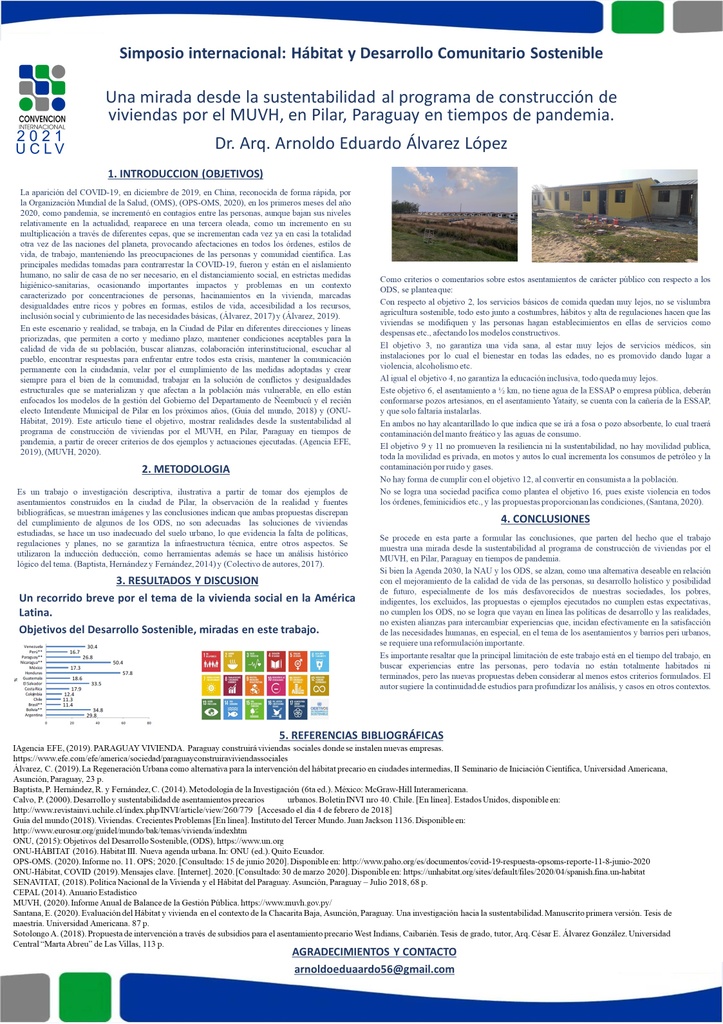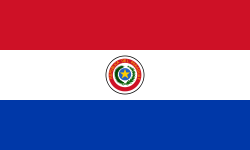Executive Secretary

Simposio Internacional "Hábitat y Desarrollo Comunitario Sostenible"
HAB-COM 2021

La ciudad de Pilar, llamada la Perla del Sur, es la capital del Departamento de Ñeembucú en Paraguay, distante 358 km de Asunción, la capital del país, ubicada a orillas del río Paraguay y del arroyo Ñeembucú, en la frontera con la República Argentina, caracterizada por un pueblo sencillo, con gente hospitalaria, con una rica historia, que trabaja y proyecta su futuro, en diferentes líneas de desarrollo, entre ellas el programa de la vivienda. Paraguay en su Informe a Hábitat III, plantea, garantizar una planificación y diseño urbanos sostenibles, y mejorar el acceso a una vivienda adecuada, (SENAVITAT, 2016 p. 16 y 48). El objetivo del trabajo es mostrar realidades entre los programas de viviendas del Ministerio de Urbanismo, Vivienda y Hábitat (MUVH), el cumplimiento de los Objetivos del Desarrollo Sostenible (ODS) y las politicas planteadas en el propio informe en tiempos de pandemia COVID 19. Es una investigación descriptiva, ilustrativa a partir de tomar dos ejemplos de asentamiento construidos en la ciudad de Pilar, la observación de la realidad y fuentes bibliográficas, se muestran imágenes y las conclusiones indican que ambas propuestas discrepan del cumplimiento de algunos de los ODS, no son adecuadas las soluciones de viviendas estudiadas, se hace un uso inadecuado del suelo urbano, lo que evidencia la falta de políticas, regulaciones y planes, no se garantiza la infraestructura técnica, entre otros aspectos.
The city of Pilar, called the Pearl of the South, is the capital of the Department of Ñeembucú in Paraguay, 358 km from Asunción, the capital of the country, located on the banks of the Paraguay River and the Ñeembucú stream, on the border with the Republic of Argentina, characterized by a simple town, with hospitable people, with a rich history, working and projecting its future, in different lines of development, including the housing program. Paraguay in its Report to Habitat III, raises, guarantee sustainable urban planning and design, and improve access to adequate housing, (SENAVITAT, 2016 p. 16 and 48). The objective of the work is to show realities between the housing programs of the Ministry of Urbanism, Housing and Habitat (MUVH), the fulfillment of the Sustainable Development Goals (SDGs) and the policies raised in the report itself in times of pandemic COVID 19. It is a descriptive research, illustrative from taking two examples of settlements built in the city of Pilar, the observation of reality and bibliographic sources, images are shown and the conclusions indicate that both proposals disagree with the fulfillment of some of the SDGs, the housing solutions studied are not adequate, there is an inadequate use of urban land, which evidences the lack of policies, regulations and plans, technical infrastructure is not guaranteed, among other aspects.
Sobre el ponente

Arq. Arnoldo Alvarez




